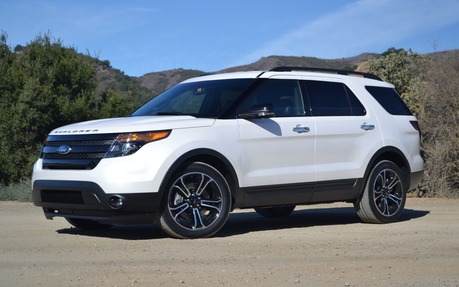2013 Ford Explorer Sport: SHO time!
Its best-in-class sales numbers don’t lie: since the new generation of the Ford Explorer arrived in 2011, it has been an unmitigated success. Originally offered exclusively with the 3.5-litre V6, the offer was diversified last year with the 2.0-litre four-cylinder EcoBoost whose main purpose is hard to explain. You may be tempted to point that the four-cylinder turbo would bring a more attractive base price, thereby making the Explorer more accessible, but you’d be wrong. In fact, this engine is an option that costs $1,000 more compared to the current version. Essentially, it helps lower fuel consumption slightly, but note that it cannot be paired with all-wheel drive and the vehicle’s towing capacity is diminished. Basically, this engine is tough to justify.
For 2013, Ford has done a 180-degree turn by offering a swankier and much more dynamic version with the 2013 Explorer Sport. With this vehicle, they aren’t aiming to rub elbows with beasts like the Grand Cherokee SRT8 and other supercharged SUVs, but they do want to offer clients a model that rivals other reasonably powerful luxury SUVs.
The F-150’s V6 EcoBoost
So, the Explorer Sport becomes the third Ford vehicle – alongside the F-150 and the Taurus SHO – to be powered by the 3.5-litre V6 EcoBoost, an engine endowed with not one, but two turbochargers. The Explorer’s engine develops the same power – 365 horses – but at 350 lbs-ft compared to 420 lbs-ft, its torque is a little more modest than that of the F-150. This engine is paired with a six-speed automatic transmission that, in the case of the Explorer Sport, gets exclusive paddle shifters behind the steering wheel to enhance the driver’s sense of control. Between us, that’s one feature that is unlikely to be used much by owners, mainly because of the vehicle type.
Since the Explorer Sport and its $48,299 price tag are at the top end of the line-up and since they wanted to make it a posh version, it has a wide array of standard equipment and gadgets. Forget front-wheel drive, all versions of the Explorer Sport feature four-wheel drive and vary the torque between front, back and laterally, depending on grip needs. This all-wheel drive is also accompanied by the Terrain Management System that includes a control dial on the console that helps you select various modes depending on the conditions.
Reminiscent of the Range Rover Sport
To make the Explorer Sport stand out, Ford didn’t simply transplant new mechanical parts, they also attacked its style. And it does not disappoint: this Sport is a looker. Some even liken it to the Range Rover Sport, especially when the body is painted black (Tuxedo Black Metallic), one of the colours chosen for the Explorer Sport. Compared to the current version, you’ll notice the black grille, matte finish and large Explorer inscription on the hood. The most striking feature is without a doubt the 20-inch black painted sport rims that bear the “Sport” inscription. You’ll like the prominent twin exhaust, while the keen eye will notice the newly tinted taillights. Basically, the style is excellent – tasteful without any excess.
Inside, the trim, upholstery and steering wheel all help this Ford stand out, and again, there’s a pronounced use of black. High praise goes to a few of the exclusive features, notably the “Sport” logo that lights up and is integrated into the rocker panels. One of the Explorer’s strengths is how spacious it is on board. The headroom is excellent, regardless of where you’re sitting. The factory standard third bench accommodates a few extra passengers or, once lowered, maximizes cargo capacity. The Explorer also includes rear seatbelts equipped with airbags, a technology that won an award this year in the 2013 edition of Le Guide de l’auto.
A more dynamic ride
At the wheel, its increased power is noticeable. As soon as you press down on the accelerator, the engine immediately unleashes its torque with the typical sound of a turbocharged V6. To better control the engine’s 365 horses, the engineers have reinforced the chassis to make it more rigid. Fitted with larger wheels, the vehicle takes on turn after turn with confidence and reduced weight transfers. The Explorer Sport isn’t trying to be a race car like some of the other more vigorous SUVs, but the changes made are still significant. The power steering has also been made more dynamic in the Explorer Sport and its brakes have more imposing discs, guaranteeing superior stamina and efficiency.
Besides all that, Ford is particularly proud of having managed to maintain a reasonable fuel consumption of 13.2 L/100 km city and 8.8 L/100 km highway. The advantage of an engine like this is that it performs like a classic V6 in normal conditions and like a V8 when the time comes.
It’s clear that the Explorer Sport won’t garner a huge percentage of sales – we predict 10% - but it represents a very attractive choice for those who are looking for a plush seven-seater at a competitive price.
| Test drive report | |
| Test model | 2012 Ford Explorer |
|---|---|
| Trim level | Sport |
| Price range | $28,349 – $41,399 |
| Price as tested | CA$41,203 |
| Warranty (basic) | 3 years/60,000 km |
| Warranty (powertrain) | 5 years/100,000 km |
| Fuel economy (city/highway/observed) | 14.7 / 10.7 / N/A L/100km |
| Options | N/A |
| Competitive models | Jeep Grand Cherokee, Nissan Pathfinder, Toyota 4Runner |
| Strong points |
|
| Weak points |
|
| Editor's rating | |
| Fuel economy | |
| Value | |
| Styling | |
| Comfort | |
| Performance | |
| Overall | |
